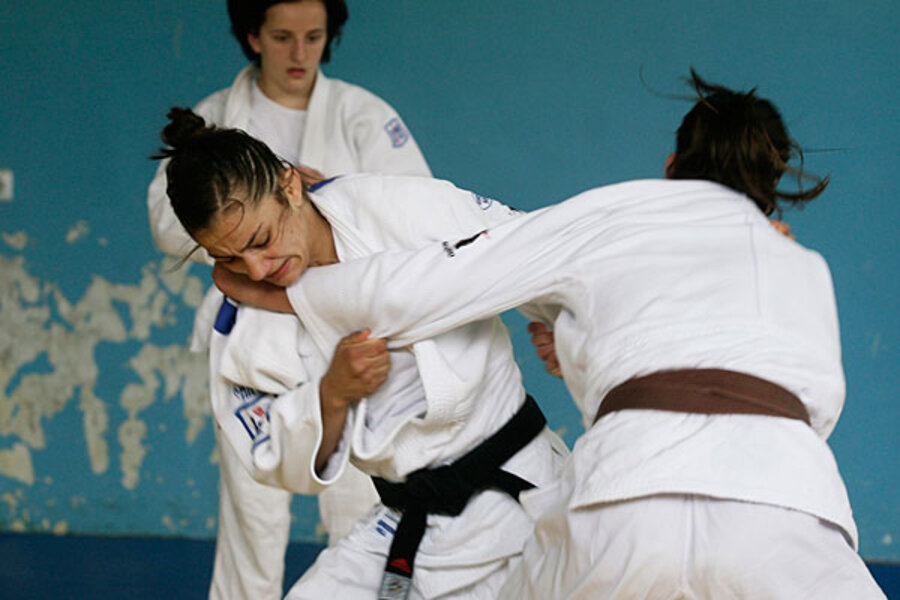Saudi Olympic athlete hit by judo head scarf ban: Safety or discrimination?
| London
One day after a female Saudi Arabian judo player arrived in London – under strict instructions from national Olympic officials to compete "wearing suitable clothing" that complies with Islamic custom – the International Judo Federation banned the wearing of head scarves Thursday.
The move was made for safety reasons, said Nicolas Messner, a federation spokesman. Judo involves grabbing opponents' clothing and using choke holds, making the head scarf – or hijab – "dangerous," he added.
Messner told the Associated Press that negotiations are ongoing with the Saudi Arabian delegation to find a compromise. But neither the Saudis nor the athlete, Wojdan Ali Seraj Abdulrahim Shahrkhani, has yet made a statement about whether she will compete. She and Sarah Attar – a middle-distance runner who grew up in California but has dual citizenship – are the first two women ever to represent Saudi Arabia at the Olympics, and the International Olympic Committee (IOC) had to lobby hard to persuade Saudi Arabia to send them.
For the first time in Olympic history, all 205 nations have sent both men and women to the Summer Games.
The decision is sure to stoke controversy. The IOC is determined to promote women's sport in Islamic countries, where most sporting authorities refuse to let women participate without a hijab. Moreover, other sporting federations, including those overseeing international soccer, taekwondo, and even rugby, allow for hijabs. Advocates say new, tear-away sport hijabs fastened by Velcro eliminate the threat of injuries.
But some in the judo community say their sport is a unique case. The judo robe, or judogi, is central to the sport, both as tradition and as an element of the competition. Many moves involve clutching an opponent's judogi in order to throw her. Women are allowed to wear a T-shirt under their judogi, but adding a head scarf is different, say some.
"It was always going to be a no-no here," said Stewart Brain, head coach of the Australian judo team, to the Sydney Morning-Herald. Because it's up around the neck," he said, "you could get your finger in there and tear it off."
"At the end of the day it doesn't fit for safety reasons," Mr. Brain added.
In making the stand, however, the International Judo Federation is moving against the tide in international sports.
The International Weightlifting Federation lifted a ban on clothing restrictions last year, allowing a team from the United Arab Emirates to compete in hijabs. This month, the international soccer federation, FIFA, approved the wearing of head scarves. It had banned them in 2007, also for safety reasons. The ban resulted in Iran having to forfeit one qualifier for the London Olympics after several women refused to remove their head scarves.
In other countries, it discouraged some Muslim women from dreams of playing for the national team.
"I strongly believe that the ban is just outright discrimination," Assmaah Helal, who plays in a women's league in Australia, told AFP. "At an international and an elite level, sports like taekwondo and rugby allow the head scarf to be worn during competitive matches, and for the world game, for the universal language that is football, to ban the head scarf ... it doesn't make sense."
Even within judo, the wearing of hijabs is not unprecedented. The Asian judo federation has allowed women to compete with hijabs.
With Shahrkhani seen as a means of accelerating broader cultural acceptance of women in sport in Saudi Arabia, the decision to ban hijabs could have broader consequences. In a country where women cannot go to men's sporting events and are forced to form underground leagues to play soccer, what "this participation does is break a taboo and break a barrier," Christoph Wilcke, a Saudi researcher at Human Rights Watch, told US News and World Report.
"I don't think that will lead to concrete changes led by the Saudi government," he said. "What I think it will do, it will increasingly encourage women in Saudi Arabia to take matters into their own hands, which they're doing already."
Shahrkhani is scheduled to compete on Aug. 2 in the heavyweight (over 78 kilogram) event.





